Excerpts from Jim Conrad's
Naturalist Newsletter
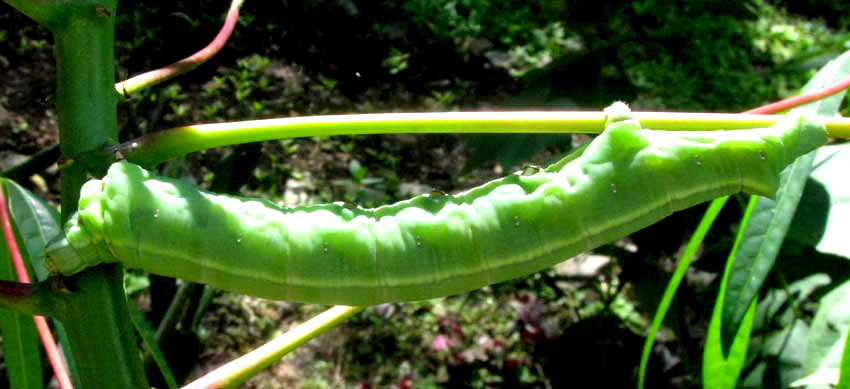
from the November 27, 2011 Newsletter issued from Hacienda Chichen Resort beside Chichén Itzá Ruins; limestone bedrock; elevation ~39m (~128ft), N20.675°, W88.569°; central Yucatán state, MÉXICO
CASSAVA HORNWORM
One morning this week at dawn I was surveying the plantings in front of the hut when I noticed several new leaves missing from my eight-ft-high Manioc plant. The long, stiff, reddish petioles were still there but the deeply palmate-divided blades had been snipped off! Moreover, the thief still lurked in plain view though well camouflaged. You can see it all below:
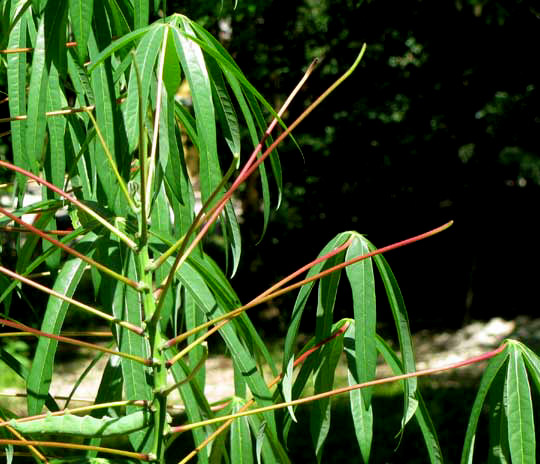
In that picture the culprit is seen in the lower, left corner. A close-up of the same is shown at the top of this page. That critter is about four inches long (10cm). He's holding completely still, even though I had to bend the branch down for a good view. He was using the old "If-I-don't-move-he-won't-see-me trick," and it almost worked. Notice the stubby appendage at the tail end (the right). It's like a hornworm's tail without the "horn," or spine.
I couldn't have been more tickled with the ID sent me by volunteer identifier Bea in Ontario when she came up with this: It's the Cassava Hornworm, which metamorphoses into the Ello Sphinx Moth, ERINNYIS ELLO. The neat thing is that Cassava is another name for my Manioc. This caterpillar was exactly where his name said he ought to be. When you run into such instances, you get a feeling that Nature knows what She's doing. There's only three or four Cassava plants in the area, and the mama sphinx moth had found one.
On the Internet Bill Oehlke is king of sphinx moths. He says that the species is distributed pretty much throughout tropical America, including southern Florida. He also says that the hornworms feed mainly on members of the Euphorbia/Poinsettia Family, of which Manioc/Cassava is a member, but also Papayas and Guavas and a few other hosts not in the Euphorbia Family. Apparently one reason the species enjoys a wide distribution is its wide range of host foods.
That's a close-up of the head area below:
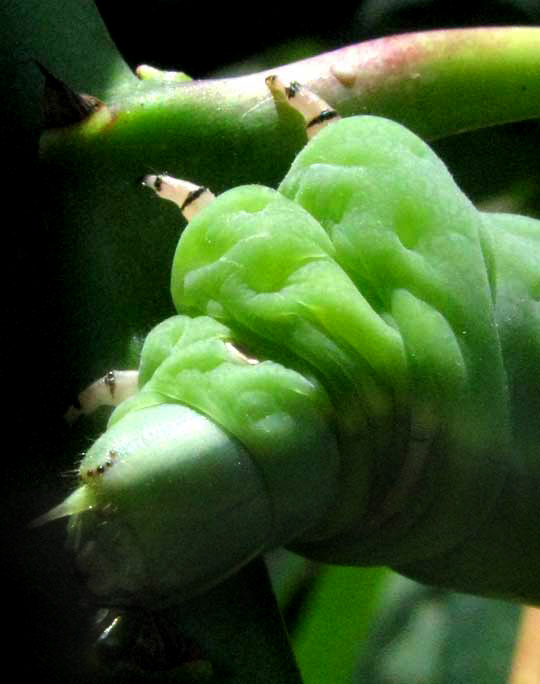
from the June 4, 2017 Newsletter issued from Rancho Regensis north of Valladolid, Yucatán, MÉXICO;
elevation ~40m (~130 ft), N~20.876°, W~88.170°
CASSAVA HORNWORM'S MANY FACES
Above we look at a large, juicy hornworm that in 2011 fed on the Cassava bush in front of the hut at Hacienda Chichen. Volunteer identifier Bea in Ontario identified the caterpillars as Cassava Hornworms. With the advent of our rainy season, the rancho's Cassava bushes are being defoliated by large, succulent hornwoms all displaying the same general form as the Cassava Hornworms back at Hacienda Chichen, but our rancho caterpillars display a bewildering variety of colors and patterns. Below, you can see a sample in my hand, plucked from just one tattered Cassava:
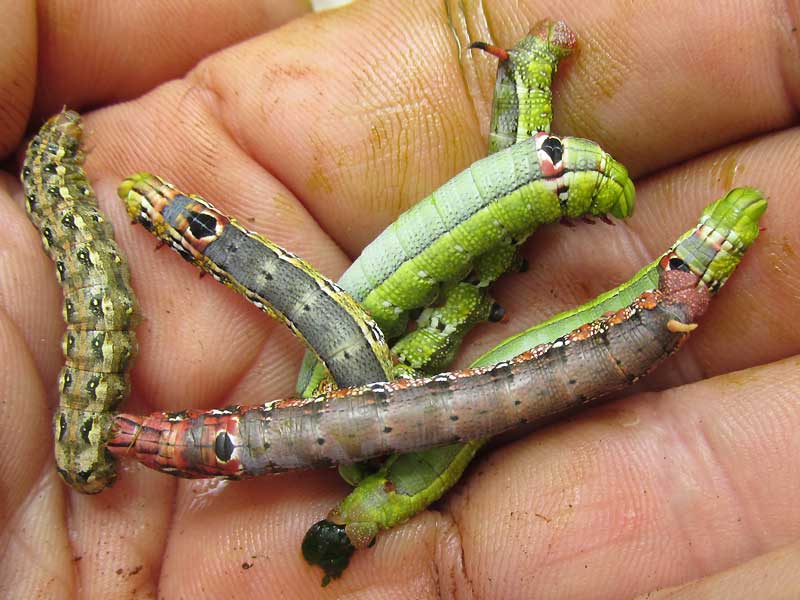
In mid-morning, the above caterpillars, having devoured the bushes' broad leaves, now congregated at the bases of the ravaged leaves' naked petioles, head-down, as shown below:
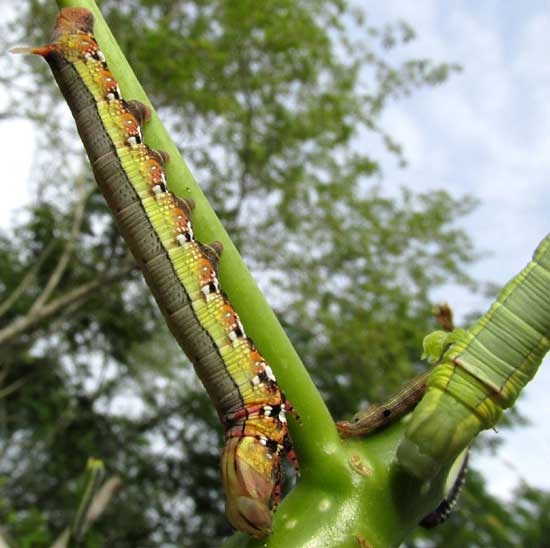
In general, the smaller, younger caterpillars are darker, like the one shown below:
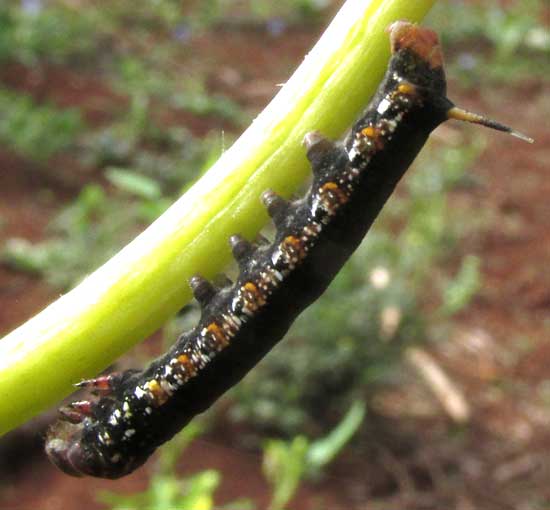
These caterpillars not only attacked our Cassavas but also Chaya trees. That's not surprising, since Cassava and Chaya both belong to the Spurge/Euphorbia Family, the Euphorbiaceae. However, they also attacked our Papaya, in a whole different family. Out in the woods I see them on several wild, native plants, too.
The caterpillars' variation in appearance is so striking that I was insecure about calling them all Cassava Hornworms, so the matter was looked into on the Internet. I couldn't find much more than several authors referring to the Cassava Hornworm's great variations in color.
In the end, I'm still insecure calling them all Cassava Hornworms, though they all do share the same structure. Also, plants in the Spurge/Euphorbia Family normally contain diverse powerful toxins that keep most caterpillars from feeding on them, so that supports the idea that they are indeed all Cassava Hornworms, Erinnyins ello.